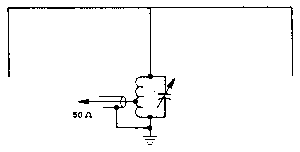 |
Bobtails and Half Squares These antennas offer big gun DX performance on the low bands, yet they are surprisingly simple to build. Try one- you will like it! |
|
|
Bobtails are vertical arrays that look like the letter "E" turned 90°
clockwise onto its tails. They have 3 quarter wave vertical elements and are one
wavelength long.
 The Half Square is a shortened
Bobtail- it has 2 quarter wave vertical elements and is a
half wave long.
The tops of the verticals are all connected together by a wire or other
conductor. The bottoms of the verticals are all insulated from ground.
Bobtails are fed from the bottom of the middle element.
Half squares may be fed at either end-
it matters very little in the resulting pattern.
The Half Square is a shortened
Bobtail- it has 2 quarter wave vertical elements and is a
half wave long.
The tops of the verticals are all connected together by a wire or other
conductor. The bottoms of the verticals are all insulated from ground.
Bobtails are fed from the bottom of the middle element.
Half squares may be fed at either end-
it matters very little in the resulting pattern.These antennas belong to the 'inverted ground plane' family. They work best voltage-fed, rather than current-fed. You should not connect coax directly to the tails. Current-fed antennas like the dipole have low impedance feedpoints and are a good match to coax. The impedance at the tips of a dipole is high, however- in the thousands of ohms, like the bobtail. Fortunately it is easy to voltage-feed the bobtail with a simple LC parallel resonant circuit connected between the element tip and ground. With the point of highest RF current a quarter wave up in the air, ground requirements are much less stringent than with ground-driven, current-fed verticals which need many radial wires to work well. It is customary to use only a small ground screen as the feedpoint counterpoise. A 3 by 5 foot piece of wire cloth is often enough, even on 80 meters. It can be supported a few feet up or it can be laid directly on the ground or even on a roof. It works much better than a ground rod, which may be connected to the counterpoise but should be thought of only as a lightning ground. A coax feedline can be connected to a tap near the grounded end of the coil and the tap adjusted for best SWR, or even better, inductive link coupling can be used. The horizontal pattern of a bobtail is a bidirectional figure 8 broadside to the plane of the antenna. The two lobes are rather narrow- only about 50°. It has a respectable gain of about 5dB over a single vertical. The half square has a beamwidth of about 60° and a gain of about 4dB. Apparent gain for DX (over single verticals or low horizontal antennas) will seem to be greater. Both antennas have good side rejection that helps hear the DX better. The bobtail has a cleaner pattern that better rejects close-in noise and signals (some of your competition in the pileups.) The vertical angle of radiation is low, in the 20° to 30° range, depending on the conductivity of the local earth. Note that the bobtail is primarily a low bands antenna useful on 30 meters and below. 30 is a transitional band where vertical and horizontal antennas both do well for DXing. For 20 meters and up, almost any horizontal antenna at reasonable height will usually do better than a vertical (unless your location happens to be over salt water.) I did build a 20 meter bobtail once in an emergency when the yagi atop my tower had failed and there was a DXpedition to a rare country coming up. The center tail was voltage-fed, with the feedpoint on my roof at about 17 feet. The stations I worked reported it had a potent signal. There have been favorable reports in the literature as well. Perhaps these antennas are underrated and underappreciated on the high bands. I doubt it is worth bothering with one for 20 meters and above, however, if you are able to put up a tower and yagi. New bobtail owners often report great success with their antenna. It is designed for DXing, not for close-in work where low, horizontally polarized antennas are more appropriate. Mounted at heights of about 25-30 feet for 30 meters and 35-40 feet for 40 meters, these simple antennas deliver DX performance that rivals horizontal antennas in the 100+ foot class. Furthermore, at these heights it is practical to use trees or simple wood or metal masts to support the wires. Metal tubing or pipe masts can also double as the vertical elements. If you have tall trees as I do, 80 meters is not out of the question. Mounted at 70 feet, the tails of a wire 80m half square will be a few feet off the ground. I have used both a 40 meter bobtail and 80 meter half squares and was very pleased with them. I would not hesitate to build some again, under the right circumstances. They are a hard-to-beat combination of DX punch and simplicity.
Editors note, June 2015: Please see new entries on "Grounding and Feeding" and Bibliography pages. |
| More about Bobtails and Half Squares: |
|
Bobtail/Half Square Grounding and Feeding Beverage and Half Square Bibliography (includes articles by the inventor, W6BCX) Detailed plans for building matching networks for your favorite bands Construction notes and important safety issues User Comments from Bobtail and Half Square owners Half Square/ Bobtail Articles Critique |
|
Bobtail and Half Square users: Please email your experiences with these antennas to be included in the User Comments section. |
| Send Comments to K3KY | The Low Bands | PREV |
| HOME | K3KY's DX Toolbar | Grounding and Feeding | NEXT |
|
|